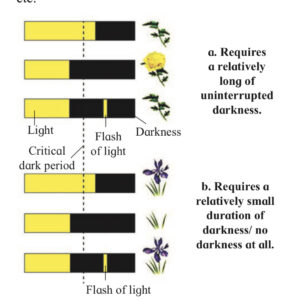Plants, categorized based on their photoperiodic response, fall into three distinct groups: Short Day Plants (SDP), Long Day Plants (LDP), and Day Neutral Plants (DNP).
1. Short Day Plants (SDP):
i. Flowering in SDPs occurs when the photoperiod is shorter than the critical length, typically during winter and late summer.
ii. SDPs, also known as long night plants, necessitate an uninterrupted dark period for flowering.
iii. Even a brief interruption of the dark period prevents flowering in SDPs.
iv. Examples of short-day plants include Dahlia, Tobacco, Chrysanthemum, Soybean, Cocklebur, and cotton.
2. Long Day Plants (LDP):
i. LDPs bloom during the summer and require a light duration exceeding the critical photoperiod for flowering.
ii. Termed short night plants, LDPs thrive with a brief dark period.
iii. LDPs can flower if a long dark period is briefly interrupted by light. Examples include pea, radish, sugar beet, cabbage, spinach, wheat, and poppy.
3. Day Neutral Plants (DNP):
a. DNPs exhibit year-round flowering unaffected by light duration (photoperiod).
b. Referred to as day-neutral plants, they lack a specific photoperiod requirement.
c. Examples of day-neutral plants encompass Cucumber, tomato, sunflower, maize, and balsam.
Photoperiodism:
